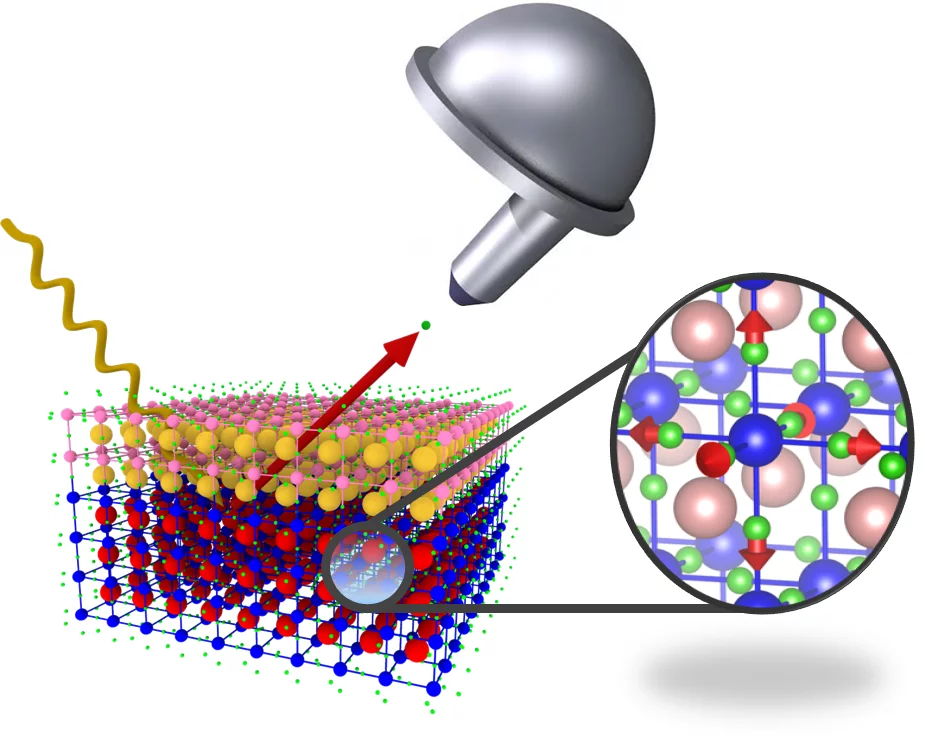Computers and other electronic devices account for a substantial portion of worldwide energy use. With today’s technologies, it is not possible to reduce this energy consumption significantly any further; chips in the energy-saving electronics of the future will hence have to be made from novel materials. Researchers at the Paul Scherrer Institute PSI have now found important clues in the search for such materials.
They have investigated a material that intrinsically possesses the needed characteristics: It is magnetic, and it can conduct electrical current completely without resistance. The disadvantage: It exhibits these properties only at very low temperatures at which no computer can run. At realistic operating temperatures, in contrast, current in the material slows down markedly. With help from experiments at the Swiss Light Source SLS of the Paul Scherrer Institute, the researchers were able to determine the causes for the impeded current flow. Their results might now help in targeted development of new materials capable of retaining these special properties at higher temperatures, which could find application in future computers. The researchers report their findings in the journal Nature Communications.
Reducing energy use is a basic challenge in the development of the electronics of the future. The giant computer centres behind Internet search engines or social media, for example, consume as much energy as a city. Energy-saving computers, however, call for a fundamental change: Novel materials will have to replace the semiconductors that have, for decades, formed the foundation of all solid-state electronic devices — from early transistor radios to the smartphone.
Among the especially promising candidates are the oxides — complex compounds of metals with oxygen,
explains Vladimir Strocov, a scientist at the Paul Scherrer Institute. Electronic components made from certain oxides could take over the function of today’s transistors and would consume only a small fraction of the energy.
Present-day microchips contain billions of transistors, which are responsible for a large portion of the chips’ energy use.
Material deformation is responsible for lethargic — or unimpeded — current flow
Now Strocov’s PSI research team, together with collaborators at ETH Zurich and the Japanese research institute RIKEN, has investigated a material that really does possess the necessary characteristics for application in these components: It is magnetic and superconducting — that is, it can conduct electrical current completely without resistance. The disadvantage: It exhibits these properties only at very low temperatures impractical for operating a computer. If the temperature is raised, in contrast, current flow in the material becomes markedly slowed down. As they report in a study in the journal Nature Communications, the researchers have now been able to determine the reasons for the impeded current flow. Apparently, this stems from the same phenomenon that enables the current to flow unhindered at low temperatures,
Strocov explains. Our results could help in the targeted development of new materials that will still, at higher temperatures, be suitable for use in novel components and thus in future computers.
An electrical current flowing through a material is identical with electrons moving through the material. Regularly ordered, largely immobile ions form the framework of such materials. The electrons that flow in the material pull on the ions and thus deform the framework,
explains Claudia Cancellieri, co-author of the study and former PSI-scientist now working at Empa, the Swiss Federal Laboratories for Materials Science and Technology. These ions in turn attract the electrons and, in this way, put the brakes on them.
But apparently the same deformation enables the material to become superconducting at low temperatures. In a superconductor, electrons become bound together in pairs and then, jointly, can move unhindered through the material. At low temperatures, the deformation of the material framework is responsible for the pairwise binding of the electrons,
Cancellieri says. With this knowledge, researchers could alter similar materials in a targeted way so that they also remain superconducting at higher temperatures. One approach would be to use special techniques from nanotechnology to replace individual oxygen atoms in the material with atoms of another element possessing extra electrons.
Observing current deep in the material
The material that the researchers investigated in their experiments is not a single oxide, but rather a combination of two oxides with the chemical formulas LaAlO3 and SrTiO3. Although the two oxides alone conduct no current, when they are joined together, current can flow along the interface between them. In general, the combination of two oxides can have novel properties that could be useful in future devices. The researchers measured the current flow at the interface between these materials using high-energy synchrotron light at the Swiss Light Source of the PSI. When it comes to such challenging experiments, the local beamline ADRESS is a leading facility worldwide.
Text: Paul Scherrer Institute/Paul Piwnicki
About PSI
The Paul Scherrer Institute PSI develops, builds and operates large, complex research facilities and makes them available to the national and international research community. The institute's own key research priorities are in the fields of matter and materials, energy and environment and human health. PSI is committed to the training of future generations. Therefore about one quarter of our staff are post-docs, post-graduates or apprentices. Altogether PSI employs 1900 people, thus being the largest research institute in Switzerland. The annual budget amounts to approximately CHF 380 million.
(Last updated in April 2015)
Contact
Dr. Vladimir Strocov, Spectroscopy of Novel Materials Group,Paul Scherrer Institute, Villigen PSI, Switzerland
Telephone: +41 56 310 53 11, e-mail: vladimir.strocov@psi.ch
Original Publication
Polaronic metal state at the LaAlO3/SrTiO3 interfaceC. Cancellieri, A.S. Mishchenko, U. Aschauer, A. Filippetti, C. Faber, O.S. Barišić,
V.A. Rogalev, T. Schmitt, N. Nagaosa and V.N. Strocov
Nature Communications, 27 January 2016
DOI: 10.1038/NCOMMS10386


